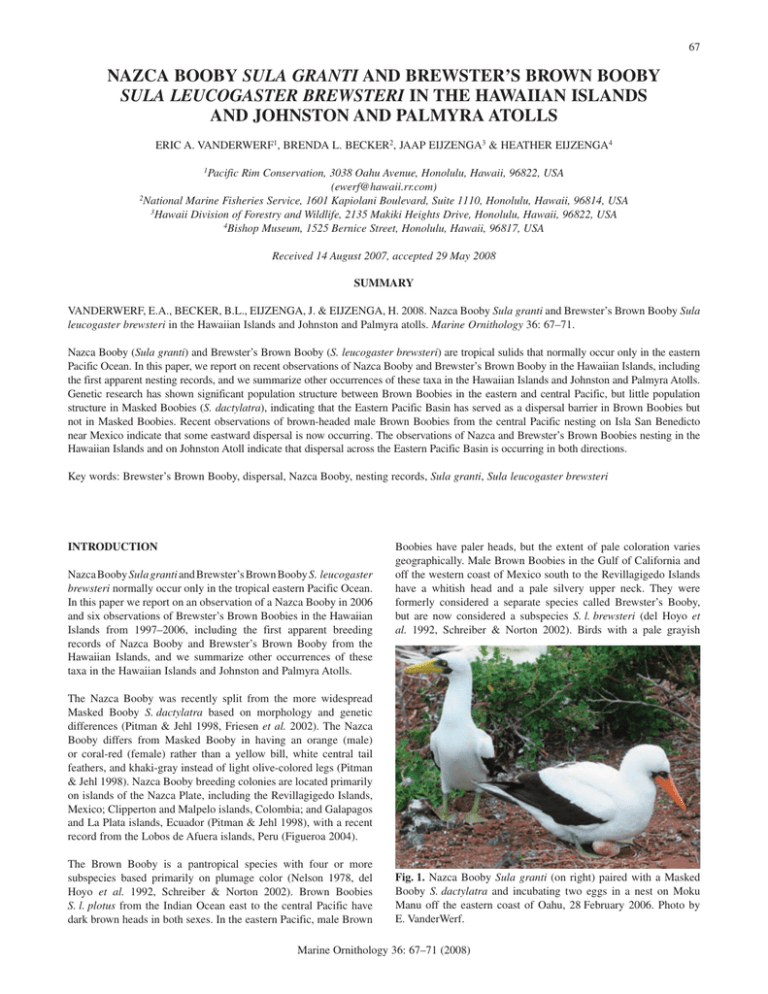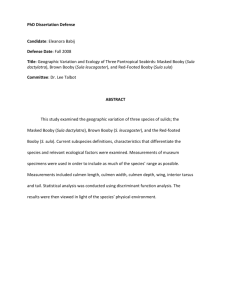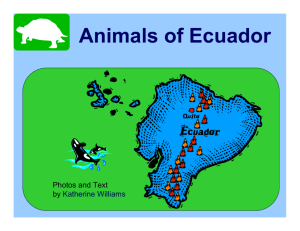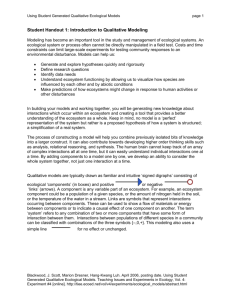NAZCA BOOBY SULA GRANTI AND BREWSTER`S BROWN
advertisement

VanderWerf et al.: Nazca and Brewster’s Brown Boobies in Hawaii 67 NAZCA BOOBY SULA GRANTI AND BREWSTER’S BROWN BOOBY SULA LEUCOGASTER BREWSTERI IN THE HAWAIIAN ISLANDS AND JOHNSTON AND PALMYRA ATOLLS ERIC A. VANDERWERF1, BRENDA L. BECKER2, JAAP EIJZENGA3 & HEATHER EIJZENGA4 1 Pacific Rim Conservation, 3038 Oahu Avenue, Honolulu, Hawaii, 96822, USA (ewerf@hawaii.rr.com) 2 National Marine Fisheries Service, 1601 Kapiolani Boulevard, Suite 1110, Honolulu, Hawaii, 96814, USA 3 Hawaii Division of Forestry and Wildlife, 2135 Makiki Heights Drive, Honolulu, Hawaii, 96822, USA 4 Bishop Museum, 1525 Bernice Street, Honolulu, Hawaii, 96817, USA Received 14 August 2007, accepted 29 May 2008 SUMMARY VANDERWERF, E.A., BECKER, B.L., EIJZENGA, J. & EIJZENGA, H. 2008. Nazca Booby Sula granti and Brewster’s Brown Booby Sula leucogaster brewsteri in the Hawaiian Islands and Johnston and Palmyra atolls. Marine Ornithology 36: 67–71. Nazca Booby (Sula granti) and Brewster’s Brown Booby (S. leucogaster brewsteri) are tropical sulids that normally occur only in the eastern Pacific Ocean. In this paper, we report on recent observations of Nazca Booby and Brewster’s Brown Booby in the Hawaiian Islands, including the first apparent nesting records, and we summarize other occurrences of these taxa in the Hawaiian Islands and Johnston and Palmyra Atolls. Genetic research has shown significant population structure between Brown Boobies in the eastern and central Pacific, but little population structure in Masked Boobies (S. dactylatra), indicating that the Eastern Pacific Basin has served as a dispersal barrier in Brown Boobies but not in Masked Boobies. Recent observations of brown-headed male Brown Boobies from the central Pacific nesting on Isla San Benedicto near Mexico indicate that some eastward dispersal is now occurring. The observations of Nazca and Brewster’s Brown Boobies nesting in the Hawaiian Islands and on Johnston Atoll indicate that dispersal across the Eastern Pacific Basin is occurring in both directions. Key words: Brewster’s Brown Booby, dispersal, Nazca Booby, nesting records, Sula granti, Sula leucogaster brewsteri INTRODUCTION Nazca Booby Sula granti and Brewster’s Brown Booby S. leucogaster brewsteri normally occur only in the tropical eastern Pacific Ocean. In this paper we report on an observation of a Nazca Booby in 2006 and six observations of Brewster’s Brown Boobies in the Hawaiian Islands from 1997–2006, including the first apparent breeding records of Nazca Booby and Brewster’s Brown Booby from the Hawaiian Islands, and we summarize other occurrences of these taxa in the Hawaiian Islands and Johnston and Palmyra Atolls. Boobies have paler heads, but the extent of pale coloration varies geographically. Male Brown Boobies in the Gulf of California and off the western coast of Mexico south to the Revillagigedo Islands have a whitish head and a pale silvery upper neck. They were formerly considered a separate species called Brewster’s Booby, but are now considered a subspecies S. l. brewsteri (del Hoyo et al. 1992, Schreiber & Norton 2002). Birds with a pale grayish The Nazca Booby was recently split from the more widespread Masked Booby S. dactylatra based on morphology and genetic differences (Pitman & Jehl 1998, Friesen et al. 2002). The Nazca Booby differs from Masked Booby in having an orange (male) or coral-red (female) rather than a yellow bill, white central tail feathers, and khaki-gray instead of light olive-colored legs (Pitman & Jehl 1998). Nazca Booby breeding colonies are located primarily on islands of the Nazca Plate, including the Revillagigedo Islands, Mexico; Clipperton and Malpelo islands, Colombia; and Galapagos and La Plata islands, Ecuador (Pitman & Jehl 1998), with a recent record from the Lobos de Afuera islands, Peru (Figueroa 2004). The Brown Booby is a pantropical species with four or more subspecies based primarily on plumage color (Nelson 1978, del Hoyo et al. 1992, Schreiber & Norton 2002). Brown Boobies S. l. plotus from the Indian Ocean east to the central Pacific have dark brown heads in both sexes. In the eastern Pacific, male Brown Fig. 1. Nazca Booby Sula granti (on right) paired with a Masked Booby S. dactylatra and incubating two eggs in a nest on Moku Manu off the eastern coast of Oahu, 28 February 2006. Photo by E. VanderWerf. Marine Ornithology 36: 67–71 (2008) 68 VanderWerf et al.: Nazca and Brewster’s Brown Boobies in Hawaii forecrown S. l. etesiaca occur on islands off Central America and Colombia (Harrison 1983, Schreiber & Norton 2002). The palest form, in which the entire head and neck are white in males, breeds on Clipperton Island and is sometimes referred to as S. l. nesiotes (Pitman & Balance 2002, Schreiber & Norton 2002). OBSERVATIONS On 28 February 2006, EV, JE and HE observed an adult Nazca Booby on Moku Manu, a small islet located off the eastern coast of Oahu. The bird had an orange bill with a slightly concave culmen and white central tail feathers, which are characteristic of the Nazca Booby (Fig. 1, Pitman & Jehl 1998). The legs were grayish-green and not very different in color from those of nearby Masked Boobies (Fig. 1). The Nazca Booby was paired with a Masked Booby and was incubating a nest with two eggs (Fig. 1). No vocalizations by the bird were noticed, but based on the orange color of the bill, it may have been a male. EV and JE returned to Moku Manu on 16 October 2006 (nearly 8 months later) and searched for the Nazca Booby but did not see it. There was no juvenile where the nest had been, but a chick from an egg laid in February would have fledged well before October. On 15 and 21 March 1997, BB and A. Pairis observed an adult Brown Booby with a whitish head and pale upper neck standing on a rocky ledge at the western shoreline of Laysan Island. On 28 June, A. Pairis observed a similarly-colored Brown Booby with another Brown Booby on a dead Tournefortia tree. No photos were taken. All three observations were in the same area and likely were of the same bird. From 15 April to 23 July 1998, an adult male Brown Booby with a white head, pale grayish neck, and blue facial skin was observed on Fig. 2. Male Brewster’s Brown Booby Sula leucogaster brewsteri (front) attending a nest with an egg and nestling on Laysan Island, 22 June 1998. Photo by B. Becker. the western side of Laysan Island by BB, B. Byrd and D. Dick. It was observed mounting a female Brown Booby on 25 and 29 April, and on 4 May, the male was sitting on a nest at the vegetation edge near the beach berm. The nest was alternately attended by the male and the female. On 17 June, a naked hatchling and an egg were observed with the male attending the nest, and photographs were taken on 22 June (Fig. 2). By 8 July, only a single chick was present with the adult male. At least one of the adults was on the nest through 23 July when the field camp was disbanded. The nestling was at least 36 days old when observations ended. In 1999, there were three sightings of a light-headed, pale-necked Brown Booby on Laysan. BB observed one on 25 April standing with six other Brown Boobies on the rocky ledge in the same area where one was seen in 1997 and 1998, and again on 2 May standing on a rocky ledge at the southern shore of the island. On 8 June, P. Bertilsson-Friedman observed one on the southeast side of the island. No photographs were taken. Another nesting by a Brewster’s Brown Booby was observed on Lisianski Island by P. Bertilsson-Friedman on 18 April 2000. A pale-headed and light-necked Brown Booby was sighted 15 days earlier on 3 April by BB, and was likely the same bird. No further observations were documented. A male Brown Booby with a white head and pale grayish neck was observed by JE and HE on Kure Atoll on 4 and 16 June 2006 (Fig. 3). On 16 October 2006, EV and JE observed an adult Brown Booby with a whitish head and upper neck and a pale grayish bill on Fig. 3. Male Brewster’s Brown Booby Sula leucogaster brewsteri on Kure Atoll, 16 June 2006. Photo by H. Eijzenga. TABLE 1 Summary of Nazca Booby Sula granti records in the Hawaiian Islands Year Location Observations Observer Source 2005 Tern Island, FFS 21 Jul + 2 weeks thereafter, 13 Oct. Possibly female based on bill color. L. Takahashi, USFWS Sightings db, pers. comm. 2006 Moku Manu, Oahu 28 Feb. Paired with a Masked Booby and incubating 2 eggs. E. VanderWerf, J. and H. Eijzenga This paper Tern Island, FFS Sporadically in much of 2007 through Mar 2008. Photos by I. Jones, 13 Mar. E. Conrad, I. Jones, B. Erickson, D. Zabriskie, S. Luecht Pers. comm. 2007–2008 FFS = French Frigate Shoals; USFWS = US Fish and Wildlife Service; db = database. Marine Ornithology 36: 67–71 (2008) VanderWerf et al.: Nazca and Brewster’s Brown Boobies in Hawaii Moku Manu. The bird was standing on a rock among other Brown Boobies and Red-footed Boobies S. sula, but took flight before it could be photographed. DISCUSSION There are three records of the Nazca Booby in the Hawaiian Islands, including the one reported here (Table 1). The other two records are from Tern Island, French Frigate Shoals, where a single bird was first observed and photographed on 21 July 2005. Based on 69 the coral-pink bill color, the bird may have been a female. A single Nazca Booby was seen again at Tern Island on 13 October 2005 and sporadically throughout much of 2007 and early 2008. All the reports from Tern Island were likely of the same individual and thus may constitute a single occurrence over a three-year period, although no reports were available from 2006. The apparent nesting on Moku Manu in 2006 is the first reported breeding attempt by a Nazca Booby in the central Pacific. There are approximately 23 records of Brewster’s Brown Boobies in the Hawaiian Islands and in Johnston and Palmyra Atolls in which TABLE 2 Summary of Brewster’s Brown Booby Sula leucogaster brewsteri records in the Hawaiian Islands and Johnston and Palmyra Atolls Year Location 1955 Nuupia Ponds, Oahu 1984 Observations 18 Jun. Observer Source R.L. Pyle Sightings db Sand Island, Johnston Atoll 29 Jul. Photo of adult male with downy chick by D. O’Daniel. R.W. Schreiber, D. O’Daniel Sightings db 1994 Laysan 10 Sep, in group of 25 Brown Boobies Adams & Nevins 1994 1996 Palmyra No details available. H.D. Pratt, K. Kepler, E. Flint Pers. comm., Sightings db 1996 Laysan 14 May. Photos. J. Adams, NMFS Pers. comm. 1997 Laysan 15 and 21 Mar, 28 Jun. B. Becker, A. Pairis, NMFS This paper 1997 Laysan Oct 16. Gray head and neck, whitish-gray bill Muller, USFWS Sightings db 1997 Lisianski 1 Apr–1 Jun. One male. 7 Jun. Two males soliciting Brown Booby females. Photos. J. Adams, H. Nevins, NMFS Pers. comm. 1998 Laysan 24–25 Feb. C. Depkin, USFWS Sightings db 1998 Laysan 15 Apr–23 Jul. Male paired with Brown Booby and incubating a chick. Photos. B. Becker, B. Byrd, D. Dick, NMFS This paper 1998 Lisianski 22 Mar–9 Jul. A. Pairis, C. Cornish, NMFS Pers. comm. 1999 Laysan 25 Apr–8 Jun. B. Becker, P. Bertilsson-Friedman, This paper NMFS 1999 Lisianski 18 Mar - 20 Jul. Photos. A. Pairis, L. Gibson, NMFS Sightings db, HRBP 1363 2000 Laysan 30 Jun and 3 Jul. D. Dick, NMFS Pers. comm. 2000 Lisianski 3, 18 Apr. On nest 18 Apr. B. Becker, P. Bertilsson-Friedman, This paper NMFS 2001 Eastern Island, Midway 30 Jan, 6, 9, 13 Feb. Small, USFWS Sightings db 2001 Kahoolawe 9, 17, 22 May. Seen flying from shore. L. Tanino Sightings db 2003 Tern Island, FFS 29 Jan-12 Feb. Two seen together on 12 Feb. Sprague, Eggleston, USFWS Sightings db 2003 Lisianski 10 Apr. Photos. S. Oates, NMFS Pers. comm. 2006 Kure 4–16 Jun. J. and H. Eijzenga This paper 2006 Moku Manu, Oahu 16 Oct. E. VanderWerf, J. Eijzenga This paper 2007–2008 Tern Island, La Perouse Pinnacles, FFS August at La Perouse, sporadically during fall and winter at Tern Island. S. Farry, NMFS, E. Conrad, Pers. comm. I. Jones, B. Erickson, D. Zabriskie, S. Luecht 2007–2008 Laysan Sep 2007 to 7 Mar 2008. Two birds on 29 Sep and 20 Oct. B. Becker, NMFS This paper db = database; NMFS = National Marine Fisheries Service; USFWS = US Fish and Wildlife Service; HRBP = Hawaii rare bird photo in Sightings database; FFS = French Frigate Shoals. Marine Ornithology 36: 67–71 (2008) 70 VanderWerf et al.: Nazca and Brewster’s Brown Boobies in Hawaii the bird was either photographed or described in sufficient detail to allow conclusive identification (Table 2). Some birds were seen sporadically over extended periods of time, so some observations could have been of the same individuals. Three records have involved breeding attempts, on Johnston Atoll in 1984, Laysan in 1998 and Lisianski in 2000 (Table 2). These observations of Nazca and Brewster’s Brown Boobies in the central Pacific and nesting attempts by mixed pairs of Nazca × Masked Boobies and of S. l. plotus × S. l. brewsteri Brown Boobies have relevance to phylogeography of boobies and dispersal patterns of tropical seabirds in the Pacific. The primary barrier to dispersal of most tropical seabirds in the Pacific is the Eastern Pacific Basin, an expanse of open ocean more than 5400 km wide between the Line Islands in the central Pacific and Clipperton Atoll in the eastern Pacific (Steeves et al. 2005). Steeves et al. (2003) found that Brown Boobies showed significant genetic population structure between the eastern and central Pacific, indicating that they rarely dispersed across the Eastern Pacific Basin. In contrast, there was little genetic population structure between Masked Boobies in the eastern and central Pacific, and thus the Eastern Pacific Basin did not serve as a barrier to dispersal and gene flow in that species. These phylogeographic patterns likely reflect the behavior of each species: Brown Boobies tend to forage close to shore and near breeding colonies; Masked Boobies often forage much farther from breeding colonies (Nelson 1978, Anderson 1993). However, recent observations of brown-headed male Brown Boobies, likely S. l. plotus, breeding on Isla San Benedicto near Mexico indicate some dispersal is now occurring (Pitman & Ballance 2002), leading Steeves et al. (2003) to conclude that the Eastern Pacific Basin was a barrier to dispersal by Brown Boobies in the past, but may no longer be an effective barrier because of geologic or oceanographic changes. The observations of Brewster’s Brown Boobies breeding in the Hawaiian Islands and on Johnston Atoll support this idea and indicate that dispersal by Brown Boobies is occurring in both directions across the Eastern Pacific Basin. In the Nazca Booby, Huyvaert & Anderson (2004) found that natal and breeding dispersal distances were usually very short, but they documented a few instances of long-distance (858–1115 km) natal dispersal eastward to islands close to South America. The recent records of Nazca Booby in the Hawaiian Islands indicate longdistance dispersal is also occurring toward the west, across the Eastern Pacific Basin. Hybridization between Nazca and Masked Boobies has been reported only rarely. A few mixed pairs and birds with bills intermediate in color have been observed on Clipperton Island (Pitman & Jehl 1998). On Isla San Benedicto in the Revillagigedo Islands, Howell & Webb (1990) reported one mixed pair, and Pitman & Ballance (2002) observed two mixed pairs and four other adults with what appeared to be intermediate-colored bills. Interbreeding of S. l. brewsteri and S. l. plotus would be more difficult to detect visually, because only males differ in appearance between these taxa (Schreiber & Norton 2002). The occurrence of both Nazca and Brewster’s Brown Boobies on Moku Manu in 2006 was unusual, but in retrospect perhaps not completely surprising. Moku Manu supports the only breeding colony of Masked Boobies in the main Hawaiian Islands, and one of two breeding colonies of Brown Boobies in the main Hawaiian Islands [the other is on Lehua Islet north of Niihau (VanderWerf et al. 2007)]. Moku Manu is closer than the Northwestern Hawaiian Islands to breeding colonies of Nazca and Brewster’s Brown Boobies in the eastern Pacific and may be more likely to receive birds that disperse from the east. Brewster’s Brown Booby has been recorded more often in the central Pacific than the Nazca Booby has, which may indicate that they disperse more widely from breeding colonies than Nazca Boobies do (Huyvaert & Anderson 2004), but also may reflect the ease of identification of these two forms and their taxonomic history. Brewster’s Brown Booby is relatively easy to distinguish from other Brown Boobies that usually occur in the central Pacific, and it was once considered a separate species. Thus observers may have been more likely to identify it and note its occurrence. Nazca Booby was split from Masked Booby recently, and the morphologic differences between these species are more subtle and were widely publicized only recently (Pitman & Jehl 1998). It is possible Nazca Booby has been overlooked because observers did not realize it was a distinct taxon and were not familiar with its field marks. Careful documentation of unusual seabirds, particularly nesting attempts, can increase our understanding of seabird biology and help to monitor changes in their distribution. Acknowledgements We thank the Hawaii Division of Forestry and Wildlife for permitting visits to Moku Manu in February and October 2006 and Ethan Shiinoki for assistance with logistics on Moku Manu. Information on observations of Nazca Booby and Brewster’s Brown Boobies on Laysan, Lisianski and French Frigate Shoals was provided by Josh Adams, Petra Bertilsson-Friedman, Barbie Byrd, Ed Conrad, Carolyn Cornish, Dorothy Dick, Brian Erickson, Shawn Farry, Beth Flint, Ian Jones, Sabrina Luecht, Hannah Nevins, Stori Oates, Amber Pairis and David Zabriskie. We also thank the late Bob Pyle for information on previous records from the Sightings database maintained at Bernice Pauahi Bishop Museum. The manuscript was improved by comments from Josh Adams and David Anderson. REFERENCES ADAMS, J. & NEVINS, H.M. 1994. Trip report: Laysan Island, 8 June–23 October, 1994 [unpublished administrative report]. Honolulu: US Fish and Wildlife Service. 29 pp. ANDERSON, D.J. 1993. Masked Booby (Sula dactylatra). In: Poole, A. & Gill, F. (Eds). The birds of North America. No. 73. Philadelphia and Washington, DC: The Academy of Natural Sciences and the American Ornithologists’ Union. DEL HOYO, J., ELLIOTT, A. & SARGATAL, J. 1992. Handbook of birds of the world. Vol. 1. Barcelona: Lynx Editions. 696 pp. FIGUEROA, J. 2004. First record of breeding by the Nazca Booby Sula granti on Lobos de Afuera Islands, Peru. Marine Ornithology 32: 117–118. FRIESEN, V.L., ANDERSON, D.J., STEEVES, T.E., JONES, H. & SCHREIBER, E.A. 2002. Molecular support for species status of the Nazca Booby (Sula granti). Auk 119: 820–826. HARRISON, P. 1983. Seabirds: an identification guide. Boston: Houghton Mifflin. 448 pp. HOWELL, S.N.G. & WEBB, S. 1990. The seabirds of Las Islas Revillagigedo, Mexico. Wilson Bulletin 102: 140–146. Marine Ornithology 36: 67–71 (2008) VanderWerf et al.: Nazca and Brewster’s Brown Boobies in Hawaii HUYVAERT, K.P. & ANDERSON, D.J. 2004. Limited dispersal by Nazca Boobies Sula granti. Journal of Avian Biology 35: 46–53. NELSON, J.B. 1978. The Sulidae. London: Oxford University Press. 1012 pp. PITMAN, R. & JEHL, J. 1998. Geographic variation and reassessment of species limits in the “Masked” Boobies of the eastern Pacific Ocean. Wilson Bulletin 110: 155–170. PITMAN, R.L. & BALLANCE, L.T. 2002. The changing status of marine birds breeding at San Benedicto Island, Mexico. Wilson Bulletin 114: 11–19. SCHREIBER, E.A. & NORTON, R.L. 2002. Brown Booby (Sula leucogaster). In: Poole, A. (Ed). The birds of North America online. Ithaca: Cornell Lab of Ornithology. [Available (subscription required) at: bna.birds.cornell.edu.bnaproxy.birds. cornell.edu/bna/species/649doi:bna.649]. 71 SIGHTINGS. n.d. Occurrence and status of birds in Hawaii project [electronic database containing more than 90 000 bird sightings.]. Honolulu: Bishop Museum. [Cited 3 November 2006] STEEVES, T.E., ANDERSON, D.J., MCNALLY, H., KIM, M.H. & FRIESEN, V.L. 2003. Phylogeography of Sula: the role of physical barriers to gene flow in the diversification of tropical seabirds. Journal of Avian Biology 34: 217–223. STEEVES, T.E., ANDERSON, D.J. & FRIESEN, V.L. 2005. A role for nonphysical barriers to gene flow in the diversification of a highly vagile seabird, the Masked Booby (Sula dactylatra). Molecular Ecology 14: 3877–3887. VANDERWERF, E.A., WOOD, K.R., SWENSON, C.S., LEGRANDE, M., EIJZENGA, H. & WALKER, R.L. 2007. Avifauna and conservation assessment of Lehua Islet, Hawai`i. Pacific Science 61: 39–52. Marine Ornithology 36: 67–71 (2008)



